Epic cosmic radio burst finally seen in real time
Source: newscientist.com

A gigantic but fleeting burst of radio waves has been caught in the act for the first time, helping to narrow down the vast array of things that might cause them. Figuring out what these fast radio bursts – sometimes called blitzars – are or where they come from could help answer some of the biggest cosmological questions.
Blitzars last about a millisecond but give off as much energy as the sun does in a million years, all seemingly in a tight band of radio-frequency waves.
Their source is a mystery, but whatever causes them must be huge, cataclysmic and up to 5.5 billion light years away, says Emily Petroff of Swinburne University in Melbourne, Australia.
A top contender is the collapse of an oversized neutron star that should have given way to a black hole long ago, but was spinning so fast that relativity made it seem lighter. But other possibilities include a flare from a magnetar, a type of neutron star with an extremely strong magnetic field.
A total of nine blitzars have been reported since the first was discovered in 2007, but all of them were found weeks or years after the actual event by sifting through old data.
No afterglow
Now, using the Parkes Telescope in New South Wales, Australia, Petroff has caught one in the act.
"This is a major breakthrough," says Duncan Lorimer of West Virginia University in Morgantown, who was part of the team that discovered the first fast radio burst.
Within about seven hours, other telescopes around the world started to point towards the source, which was near the constellation Aquarius. None of them saw any afterglow at all, which is itself an interesting finding, Petroff says. That rules out some of the less likely sources like long gamma-ray bursts or supernovae.
The Parkes Telescope data alone revealed a new property of the bursts: the waves appear to be circularly polarised rather than linearly polarised, which means they vibrate in two planes, rather than one. "It's something nobody has ever measured before," Petroff says. But it's hard to know how to interpret it, she says.
Cosmic rainbow
Keith Bannister from the CSIRO, Australia's national science agency, in Sydney agrees. "Nobody knows what to make of it," he says. "All the ideas are very exotic so ruling them out is all you can do at the moment."
Lorimer hopes that soon astronomers will detect a blitzar in another frequency range, allowing it to be conclusively associated with something – a galaxy, a region of a galaxy, or even a region of intergalactic space.
If the source can be found, it will help to calculate the density of the interstellar medium for the first time, Petroff says. As the signal passes through the free electrons between stars, it is dispersed like a rainbow, with "bluer" or higher frequency waves hitting us first. The denser the medium, the greater the dispersion. Knowing the density of this medium and how it has changed over time will be a key test for theories of how the universe evolved.
Journal reference: Monthly Notices of the Royal Astronomical Society, accepted, arxiv.org/abs/1412.0342
Source: newscientist.com






















